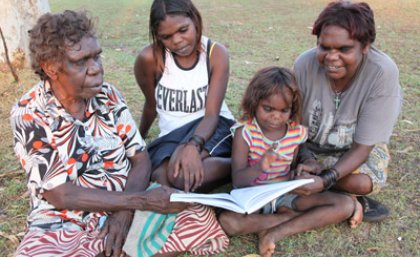
A bilingual print dictionary Gurindji to English Dictionary will be launched at Freedom Day celebrations at Kalkaringi, Northern Territory, on 23 August.
Dr Felicity Meakins from The University of Queensland's School of Languages and Comparative Cultural Studies helped capture the Northern Territory language with other linguists and Gurindji researchers over 30 years
Only 40 of the 300 Indigenous languages once spoken in Australia remain, and just 12 are still learnt by children.
Dr Meakins said compiling the resource was a difficult task because the Gurindji words did not map onto English words perfectly.
“It is a pivotal moment in the history of any language to have a dictionary compiled, because it represents an attempt to not only capture words and their meanings, but also a different world view,” Dr Meakins said.
One of Dr Meakins first tasks included sitting to eat dinner with a family for a geometry lesson, where she was asked to pass a plate lying ‘along the north side of the bowl.’
“Gurindji doesn't have terms for left and right, but has 24 different words each for north, south, east and west,” she said.
"Being Gurindji means you need to have your mental map of the world constantly activated. That's a really hard thing for English-speakers to do.”
Dr Meakins said the Gurindji people are known for their influence on Australian politics in the 1960s and ’70s, and were instrumental in gaining equal wages for Aboriginal cattle station workers.
“They were the first Aboriginal group to recover control of their traditional lands,” she said.
“Translating the Gurindji language provides a rich historical context that explains allegiances between different Indigenous groups and provides insight into changes in Australia’s natural environment.”
She hoped the bilingual dictionary captured the different ways languages provide historial and cultural context of the world, and highlighted the need to preserve Indigenous languages for future generations.
“With the loss of each language, Australia stands to lose a significant part of its linguistic and cultural richness,” Dr Meakins said.
The Gurindji to English Dictionary is available from Batchelor Press, Mimi Arts (Katherine) and Karungkarni Arts (Kalkaringi).
Media contact: Felicity Meakins f.meakins@uq.edu.au or 0411 404 546.




